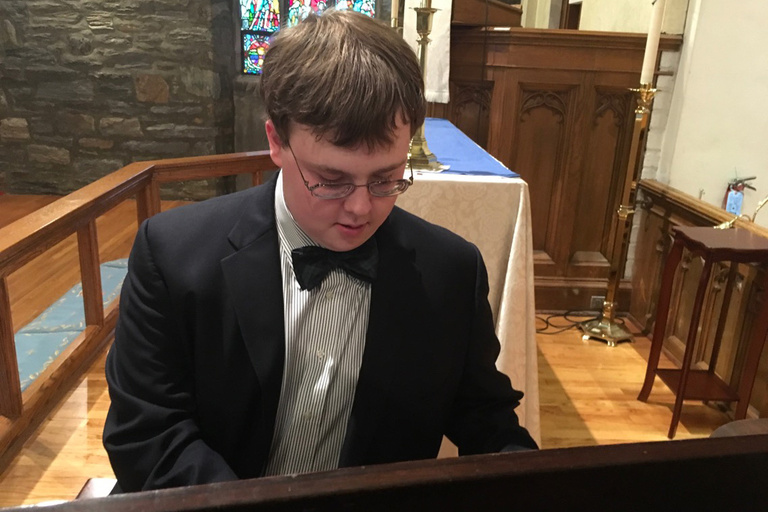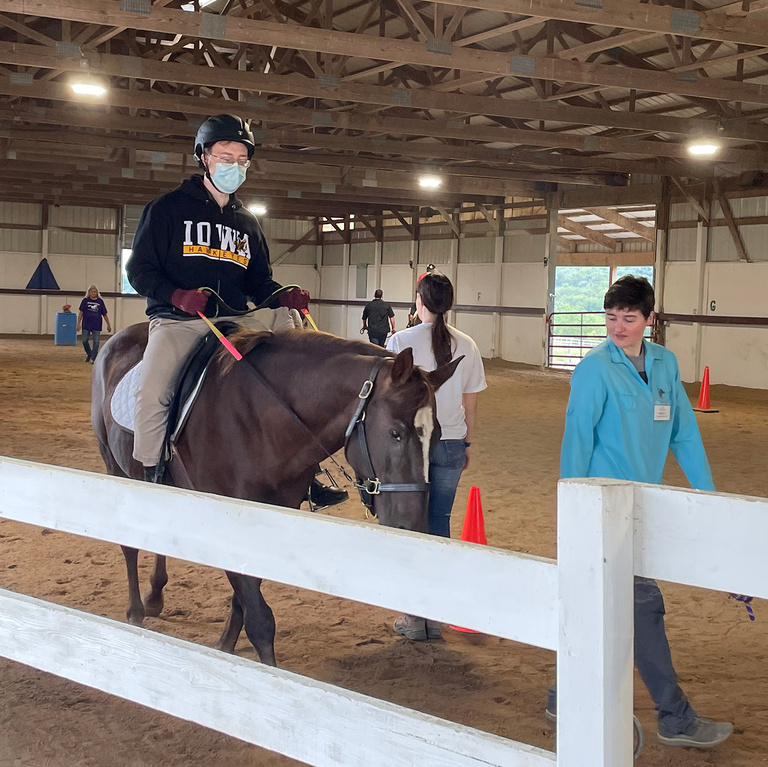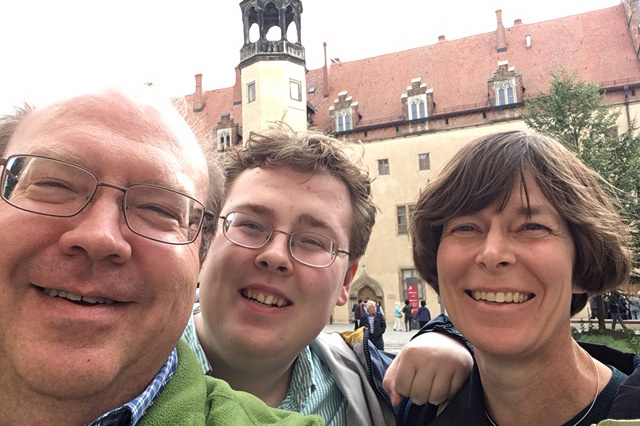When his toddler was diagnosed with autism spectrum disorder more than 20 years ago, Ted Abel expanded his research focus to include the developmental disorder. Today, the University of Iowa provides an environment where both father and son have thrived.
Story: Sara Epstein Moninger
Photography: Justin Torner and courtesy of the Abel family
Published: Feb. 14, 2025
Since being hired in 2017 as the founding director of the Iowa Neuroscience Institute at the University of Iowa, Ted Abel has overseen impressive progress: Neuroscience research funding at Iowa has increased from $65 million a year to $110 million, 30 new faculty members have come on board, and some 135 faculty across campus have joined the collaborative institute. The university, meanwhile, started an undergraduate major in neuroscience and opened a new building dedicated to psychological and brain sciences.
But one of the best things to happen to Abel since arriving in Iowa City has been personal. His son, Seamus, who is on the autism spectrum, will graduate from Iowa in May 2025 with a bachelor’s degree in German.
That Abel’s son would graduate from high school, let alone college, was not always a sure thing. Days after his birth, Seamus — named after the late Irish poet Seamus Heaney — stopped feeding. His parents were wracked with worry and fear in the neonatal intensive care unit at Children’s Hospital of Philadelphia.
Imaging revealed low-grade bleeding in the ventricles of Seamus’ brain, which Abel says explained the symptoms. Seamus was stabilized and sent home, though developmental pediatricians and neurologists closely monitored his progress. At age 3, Seamus was diagnosed with autism spectrum disorder. He didn’t see a typical classroom until the fourth grade.
“The trajectory for him was very unclear,” says Abel, who had been a junior faculty member in biology studying behavior, learning, and memory at the University of Pennsylvania when Seamus was born.

Seamus Abel, a German major, has found a home away from home in Phillips Hall, which houses the academic offices of the Division of World Languages, Literatures, and Cultures as well as a student study lounge.
Early on, however, Seamus exhibited signs of high ability, especially in reading and math. As a young child, he always pronounced new words correctly. At 3, he would identify letters formed by broken pretzel pieces, and when he was 7, he drew a baseball and included every stitch. He quickly picked up German when he started learning the language in middle school and took Advanced Placement German in high school. Outside school, he enjoyed playing piano, swimming, completing math and science lessons through Khan Academy, and beating his father in tennis.
Although Seamus is high-functioning and likes being around people, Abel says his son, now 25, faces daily challenges. He manages anxiety and has difficulty making social connections. With support, he completed high school, but while most students in his cohort with special needs moved on to group-living programs to help them transition to adulthood, Seamus did not.
“Because of his intellectual ability, we sought to find a path for him to go to college. We wanted him to have a chance to achieve a college education and learn how to write and think,” Abel says. “He’s still working to connect socially and live independently, but he’s about to graduate from college. That’s a tremendous accomplishment for Seamus. We’re extremely proud of him.”
A son finds his niche
While Abel was busy establishing the neuroscience institute at Iowa, Seamus and his mother, Noreen O’Connor-Abel, remained in Philadelphia. After his high school graduation, Seamus attended a two-year education and support program for students with autism based at the Kinney Center of Saint Joseph’s University. There he learned to navigate a traditional college experience — and prepare for his future as a Hawkeye.
Seamus and his mother joined Abel in Iowa City in June 2020, and Seamus started classes that fall. Though Seamus had been considering small colleges, Abel says enrolling at Iowa was the right choice.
“I don’t know of very many other places where Seamus could have accomplished what he’s accomplished moving here. Both the University of Iowa and Iowa City have been extraordinary for him,” Abel says. “He’s been able to do intellectual work at a high level — and do it in a place where he has support and in a place of safety with a strong sense of community. We haven’t regretted moving to Iowa City for one second.”
Abel and his wife, who works remotely as a managing editor at University of Pennsylvania Press, recall a definitive moment during Seamus’ time at Iowa. He had been accepted into the Belin-Blank Center’s Academy for Twice-Exceptionality, a program in the College of Education that works with high-ability neurodiverse students to support their campus experience and foster community engagement, and the three were at a lunch for academy students and their families.
Facts about autism spectrum disorder
- Autism spectrum disorder (ASD), a developmental disability caused by differences in the brain, is a lifelong condition often marked by challenges with social communication and interaction and repetitive behaviors.
- Research suggests that ASD develops through a combination of genetic influences as well as certain environmental risk factors, such as advanced parental age, prenatal exposure to air pollution or certain pesticides, extreme prematurity or very low birth weight, and birth complications leading to periods of oxygen deprivation. Early brain development appears to be key.
- About 1 in 6 children are diagnosed with a developmental disability, with 1 in 36 children identified with ASD, according to recent estimates from the Centers for Disease Control.
- The average age of ASD diagnosis in the U.S. is 5, with signs appearing about age 2 or 3. Boys are diagnosed with ASD four times more often than girls.
- Common co-occurring conditions are attention-deficit/hyperactivity disorder, anxiety and depression, gastrointestinal disorders, seizures, and sleep disorders.
“We were talking to other parents, and suddenly we looked around, wondering where Seamus was. And he was sitting down at a table, talking with the student group. That had not happened before — and he was 23,” Abel says. “He’s never had a real friend. The twice-exceptional academy has provided a community for Seamus, and it has helped make a large campus feel smaller.”
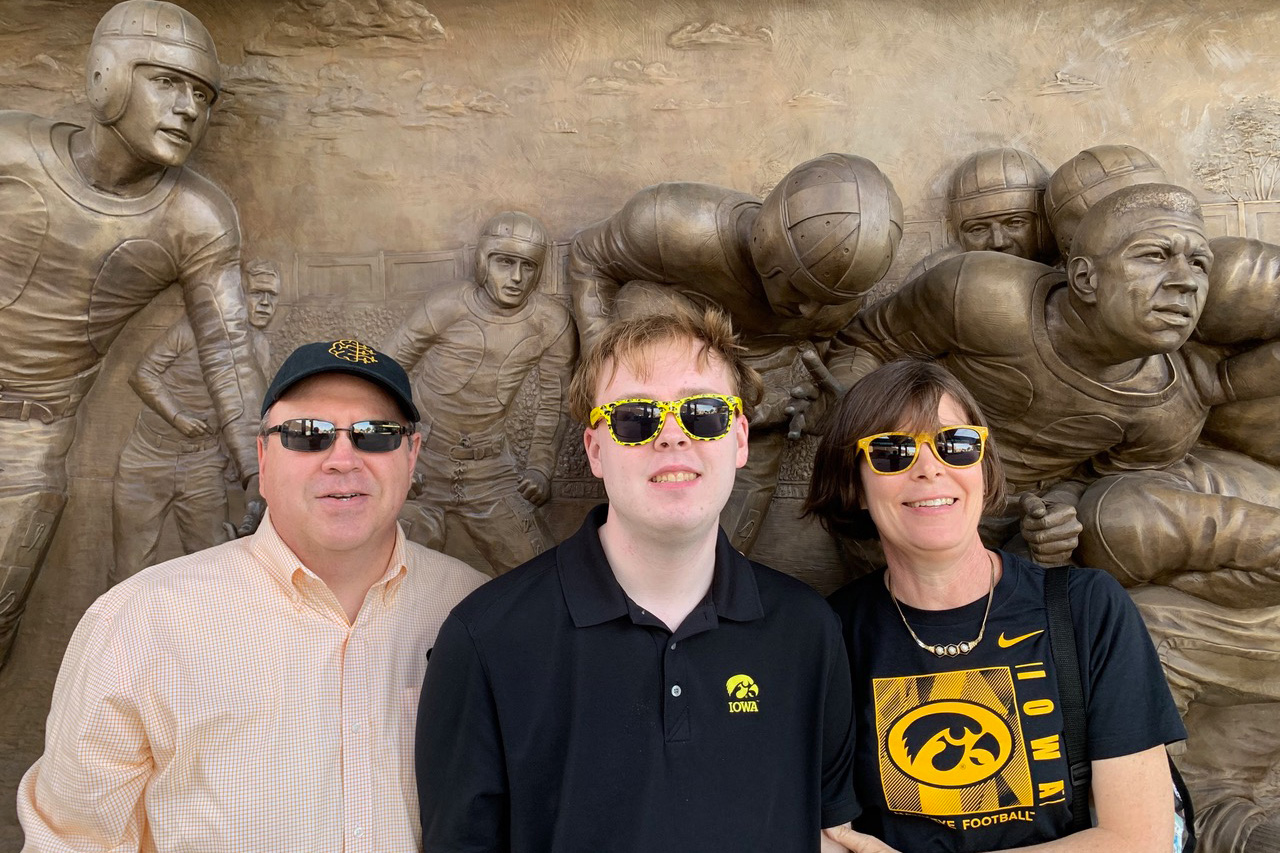
Seamus Abel stands between his parents, Ted Abel and Noreen O’Connor-Abel, at Kinnick Stadium on the University of Iowa campus in Iowa City. The family enjoys attending Hawkeye athletic events together.
“I don’t know of very many other places where Seamus could have accomplished what he’s accomplished moving here. Both the University of Iowa and Iowa City have been extraordinary for him.”
Through the academy, which started as a pilot program in 2021 with two students and now has 17 active students, Seamus sets academic and personal goals and attends weekly individual meetings with academy staff as well as group workshops. He also is connected to campus resources such as Student Disability Services, which arranges accommodations that help him focus during exams.
Thanks to professors allowing breaks, giving alternate assignments when needed, and sharing class slides in advance to help him prepare, Seamus has succeeded academically — especially thriving in his German classes, where he prides himself on proper pronunciation and correct grammar. He joined the German Club and participates in Kaffeeklatsch, a German conversation group. Phillips Hall, which houses the academic offices of the Division of World Languages, Literatures, and Cultures and a study lounge for students, quickly became a comfortable home base on campus.
In addition to his affinity for languages — he is in his second year of studying French — Seamus is fascinated by math and science. He fulfilled his rhetoric requirement with a class focused on science and technology taught by Margaret Murray, an emerita faculty member in rhetoric and mathematics and a 2024 recipient of the Hubbard-Walder Award for Excellence in Teaching. To satisfy another general education requirement, he enrolled in Murray’s Diverse Perspectives in the Mathematical Sciences, where some discussions and assignments allowed him to voice his viewpoint as a person with autism.
For Seamus, finding professors such as Murray, along with Glenn Ehrstine and Kirsten E. Kumpf Baele in the German department, gave him confidence in navigating change from one semester to the next.
“I feel my professors are pretty understanding,” says Seamus, who has only missed class for illness or an excused absence and made the dean’s list in fall of 2024. “I don’t know if you can find any other professors that are more understanding.”
Abel says the German department, with its small class sizes, has provided a supportive environment for Seamus to learn to think critically and write analytically, and its courses have given his son the skills to communicate his thoughts at a high level.
Iowa part of elite network investigating disabilities
About 1 in 6 children are diagnosed with an intellectual or developmental disability, which includes autism spectrum disorder, attention-deficit/hyperactivity disorder, blindness, and cerebral palsy.
The University of Iowa aims to prevent and treat these disabilities through biomedical and behavioral research, and in 2021 the campus became home to one of 15 federally funded Intellectual and Developmental Disabilities Research Centers (IDDRC) across the country. Other locations include Children’s Hospital of Philadelphia, Boston Children’s Hospital, and Kennedy Krieger Institute in Baltimore.
Funded through a five-year, $6.2 million grant from the National Institutes of Health, the Hawk-IDDRC, led by neuroscientist Ted Abel and developmental pediatrician Lane Strathearn, is tailored to benefit the underserved rural population.
A father finds his niche
When Seamus was diagnosed with autism, Abel broadened his research focus to include neurodevelopmental disorders. Male mice that model autism, his studies have revealed, exhibit deficits in reward learning and motor learning, behaviors mediated by circuits in the brain that enable us to learn from experience, predict what will happen next, and then choose a motor.
“This may be key to why autism is more common in boys,” says Abel, who is chair of the Department of Neuroscience and Pharmacology in the UI Carver College of Medicine and has co-authored more than 250 scientific papers. “Many individuals on the autism spectrum have trouble predicting what will happen next or coping when what they expect to happen does not occur, and that leads to difficulties in social interaction and communication.”
The field of neuroscience, Abel says, has introduced techniques from physics, engineering, chemistry, and biochemistry to manipulate and image circuits of nerve cells in the brain. He hopes to use those findings to understand how neurons in the brain work to drive behavior and then develop treatments.
His lived experience with Seamus fuels his desire to make a difference in the lives of others.
“My work on the molecular basis of memory has always been close to the field of neurodevelopment, but clearly Seamus’ diagnosis has driven me to focus on autism,” says Abel, a member of the National Academy of Medicine and a fellow of the American Association for the Advancement of Science. “In fact, we recently established at the Iowa Neuroscience Institute a research center in intellectual and developmental disabilities, one of only 15 centers funded by the National Institutes of Health. By understanding these disabilities more completely, we can develop better treatments.”
The Hawkeye Intellectual and Developmental Disabilities Research Center, or Hawk-IDDRC, is co-led by Abel and Lane Strathearn, director of the UI Division of Developmental and Behavioral Pediatrics and physician director of the Center for Disabilities and Development.
Did you know?
The University of Iowa has a long history as a center for brain research and patient care. Iowa’s first psychological laboratory opened in 1890, and in 1921 the Iowa Psychopathic Hospital opened as the first university-affiliated psychiatric department west of the Mississippi River. The campus was home to some of the leading figures in neurology, psychiatry, and psychology, including Carl Seashore, Kenneth Spence, Adolph Sahs, and George Winokur. In the 1980s, Hanna and Antonio Damasio conducted their groundbreaking brain lesion studies at Iowa, and Nancy Andreasen identified schizophrenia as a disease of the brain.
This work formed a solid foundation for the Iowa Neuroscience Institute, founded in 2017 with a transformational $45 million grant from the Roy J. Carver Charitable Trust. The institute is a collaborative team of motivated scientists who are committed to advancing knowledge using innovative and rigorous methods to investigate a range of understudied areas and clinical applications.
The center integrates basic and clinical research across the lifespan — from conception to adulthood — that is tailored to an underserved rural population and focused on the prevention, diagnosis, treatment, and amelioration of intellectual and developmental disabilities.
Together, Abel says, the broader network of centers will contribute to the development and implementation of evidence-based practices by evaluating the effectiveness of biological, biochemical, and behavioral interventions; developing assistive technologies; and advancing prenatal diagnosis and newborn screening.
“There are no barriers here. Whatever the problem is, we work together to understand it in creative and collaborative ways.”
Building on an Iowa tradition
With psychiatric and neurological disorders accounting for nearly one-fifth of all disability leading to ill health or early death worldwide, gaining a better understanding of the brain has become an international priority.
Innovative research in neuroscience had been a hallmark at Iowa long before Abel’s arrival. Iowa’s first psychological laboratory opened in 1890, and the psychiatry and neurology departments in the UI Carver College of Medicine, founded in 1919, were two of the nation’s first. Buoyed by a $45 million founding grant from the Roy J. Carver Charitable Trust and support from the UI Carver College of Medicine, Abel says his job has been to continue this tradition focusing on collaborative research into fundamental neuroscience.
“It was all here — it was just a matter of someone being able to synthesize it with resources and with people. The connections between the clinic and the bench at Iowa are seamless,” he says, motioning down the hall from his office in the Pappajohn Biomedical Discovery Building, where the institute occupies three floors. “In these offices you’ll find PhDs, MDs, and MD-PhDs, from dozens of disciplines, including pediatrics, neuroscience and pharmacology, and psychological and brain sciences. You bump into people all the time. We have people who are returning from the clinic, maybe having worked with infants who won’t stop seizing, and then coming into the lab to do cutting-edge imaging of neurons using $1 million microscopes. It’s extraordinary.”
Abel cites the work of institute member Aaron Boes as a great example. The Iowa-educated neuropsychiatrist collaborated with neurosurgeon and institute member Matthew Howard to advance a treatment for depression using noninvasive brain stimulation. They performed the first study combining transcranial magnetic stimulation (TMS) with intracranial recording of patients undergoing brain surgery to pinpoint how the human brain responds to TMS.
Iowa neuroscience major spurs interest
Since the University of Iowa established a BS in neuroscience in 2017, more than 250 students have graduated with the degree — and enrollment in the program is growing.
With new advances in the field being made every day, Iowa provides students with both a top-notch education and an opportunity to participate in cutting-edge research. The program is jointly administered by the Department of Biology and the Department of Psychological and Brain Sciences, in cooperation with the Iowa Neuroscience Institute. The curriculum provides comprehensive exposure to the entire realm of neuroscience, from molecules to behavior and cognition.
“There are no barriers here. Whatever the problem is, we work together to understand it in creative and collaborative ways. It doesn’t matter what your label is,” Abel says. “We do it this way because that’s how we will understand things better, and that’s just huge. Iowa has had an impact in neuroscience for decades, and the Iowa Neuroscience Institute has built on this legacy with the goal of transforming our understanding of neuroscience.”
While little is understood about what causes autism spectrum disorder and how best to ameliorate it, Abel says he feels momentum. He notes recent developments in treatment for the most severe genetic forms of the disorder and points to fundamental advances in our understanding of neuroscience and the regulation of gene expression during development.
Abel has identified an overarching goal for the institute to understand the genes and molecules that drive the circuits in the brain, a new field called molecular systems neuroscience.
“We know that behavior is mediated by these circuits, but now we need to connect that to the tens of thousands of molecules in the millions of neurons that give rise to these behaviors,” he says. “And we are developing the tools to do that.”
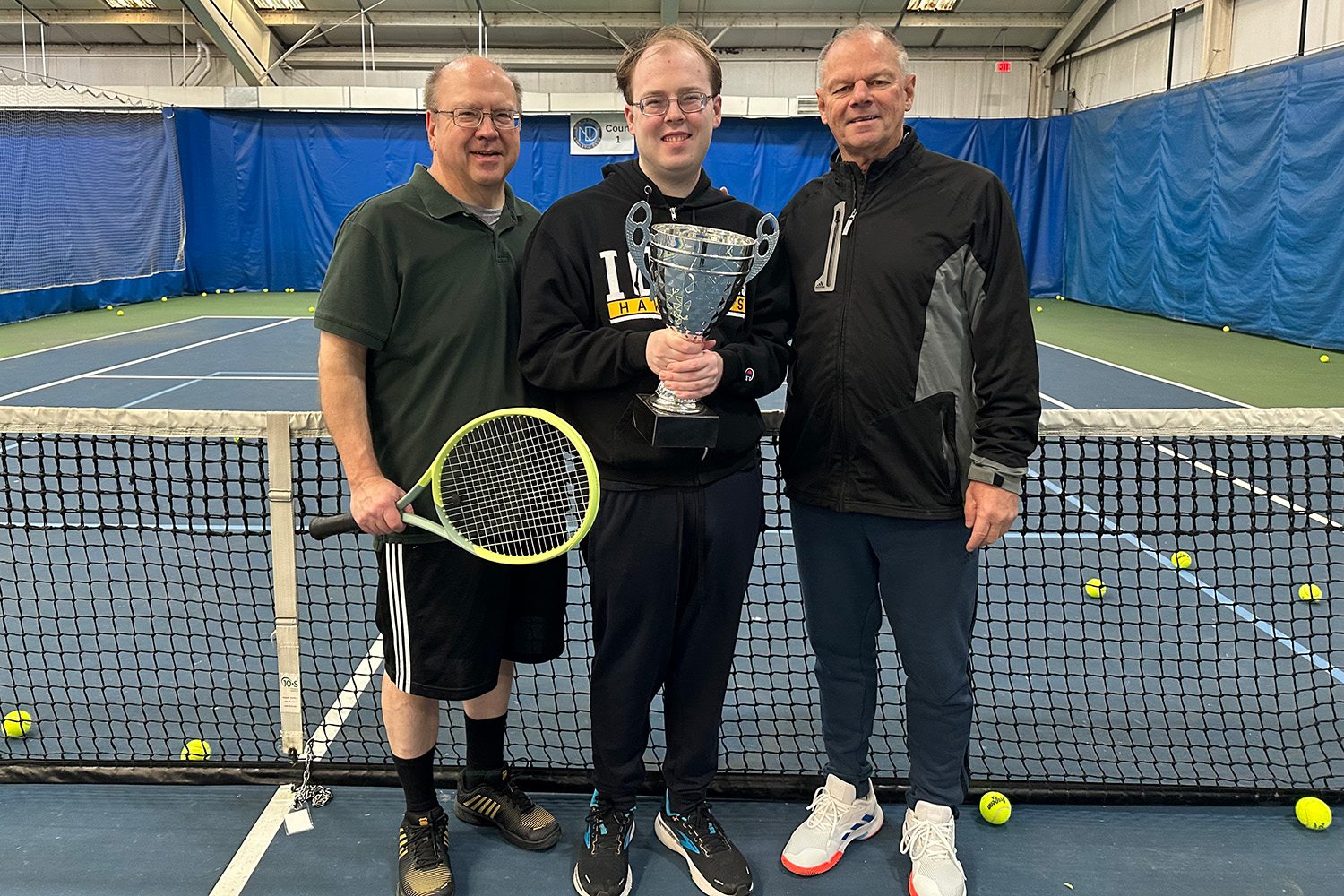
In addition to attending Hawkeye athletic events together, Seamus and his father (left) enjoy competing with each other. They take tennis lessons at the North Dodge Athletic Club in Iowa City with tennis pro Mike Shires (right), who organized a friendly father-son match.
A family looks toward the future
The cultural shift Abel has witnessed since Seamus was born is helping to speed up discoveries, and for that Abel is grateful.
“As a society, I think we are very much in the process of change for individuals with disabilities, moving from awareness to acceptance, and I hope that we’re able to continue that,” says Abel. “At Iowa, you can see that in what Seamus has been able to do with the Academy for Twice-Exceptionality. That’s the biggest arc of all.”
In addition to guiding his professional endeavors, Abel says being Seamus’ father has taught him compassion and appreciation.
“It has helped me focus on the present, on what Seamus and I can do together. So often in life, we think about where we’re going, but what we really need to focus on is where we are. Life is about having fun, in many ways,” says Abel, who frequently attends Hawkeye athletic events with Seamus. “When you think about somebody like Seamus and the challenges he faced, being in NICU and wondering what’s going to happen to him, we’ve been able to identify strengths to focus on and help him develop and grow, something that happens one step at a time. And now he’s graduating from college.”
The beginning of their parenting journey may have been marked with worry and fear, but this spring Seamus’ parents will experience one of their proudest moments as they watch Seamus cross the Carver-Hawkeye Arena stage in a black cap and gown to accept his diploma. Seamus plans to stay in the area and find a job, but before that: a celebratory family trip to Disneyland Paris.
Iowa program supports high-ability neurodiverse students
The Belin-Blank Center’s Academy for Twice-Exceptionality is a program in the College of Education that works with high-ability neurodiverse students to support their campus experience and foster community engagement. The academy started as a pilot program in 2021 with two students and now has 17 active students. Students meet weekly with staff members and participate in group workshops.

